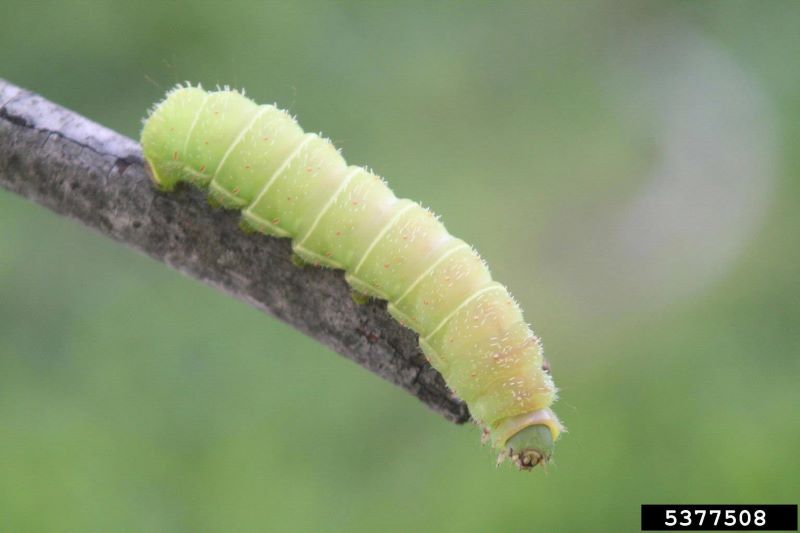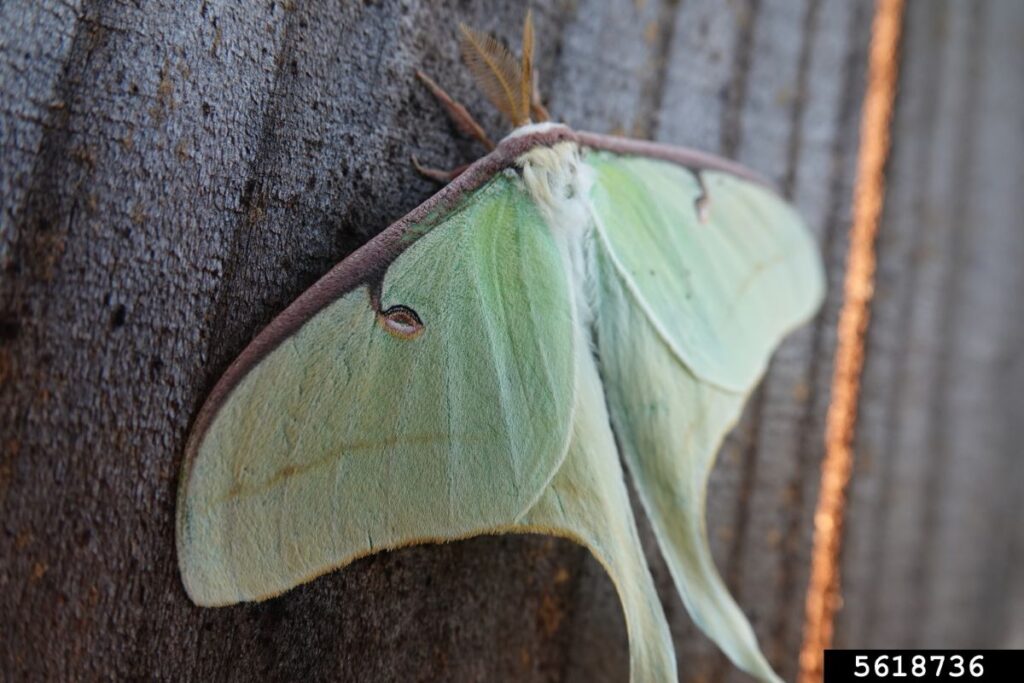Luna moth (Actias luna) is one of the most beautiful silk moths found in North America. Luna moths are not considered pests. Their larvae, which are large caterpillars, don’t usually grow large enough to cause significant damage to hosts.
Life cycle
Larval stage (caterpillar)

The caterpillar or larva of the luna moth does not have a common name. When full-grown, the caterpillar reaches a length of about three inches, is as big around as an adult’s index finger, and is harmless to people.
The caterpillar is lush green and covered with numerous short, stout hairs. The segment just behind the head is rimmed with yellow and there is a clear yellow band across the top of every abdominal segment. Several obvious bright red spots are present on each body segment.
A row of spiracles (where the caterpillar breathes) occurs along both sides of the body. Each spiracle appears as a pink spot surrounded by yellow, and there is a distinct yellow line running along each side of the body just below the spiracles.
The thoracic legs, or true legs just behind the head, are yellow and black. The fleshy prolegs, or false legs that are lost before the insect becomes an adult, are green, yellow, and black.
The caterpillar feeds on a variety of trees including hickory, persimmon, sweetgum, oak, and willow. Despite its size and appetite, it does not cause significant damage to trees. In East Texas, there may be up to three generations each year, meaning the caterpillar could be present throughout warmer months.
If found, luna moth caterpillars can be reared to the moth stage by placing them in a container with their host plant foliage and some loose leaf litter for pupation.
Pupa stage
The luna moth is a member of the family of moths known as silk moths. When the caterpillar is fully developed, it transforms to a pupa.
The caterpillar crawls to the ground and begins to weave a silk cocoon around itself. It finds a dry leaf and carefully weaves the leaf into the silk. The leaf hides most of the cocoon, making it difficult to see among other leaves and debris on the ground.
The pupa remains protected in the cocoon through winter, and the adult moth likely emerges the next spring.

Adult stage
The adult stage, most commonly found in April and May, is the spectacular pale green luna moth and has a wingspan of about four inches.
The moth is best known for the long, curved tails on its hind wings. The top edge of each front wing is bordered with a purple-brown band. Each wing has a clear eye spot bordered with black and yellow.
The moth’s body appears to be covered with white cotton. The female is slightly larger than the male, but both sexes have the same color pattern.
Male and female moths can be identified by carefully observing the antennae. They both have antennae that resemble feathers, but the male’s antennae are much fuller than the female’s. This is because the male luna moth finds his mate through odor attraction, called a pheromone, produced by the female moth.
The male is able to smell the female’s scent through his antennae. An unmated female moth placed outdoors in a screen or cloth cage may attract several male moths.
Both sexes are attracted to lights at night, a good place to look for them. Lights having a bluish tint, for example mercury vapor lamps that are commonly used for street lights and guard lights, are attractive to many insects, including the luna moth. While yellow and red lights attract very few insects.